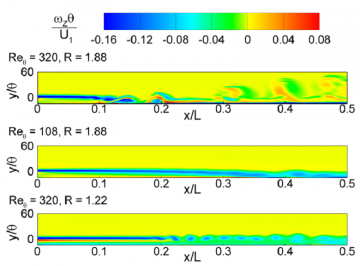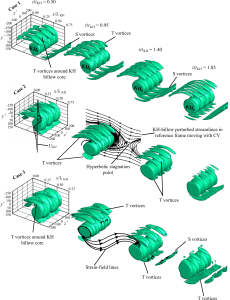The instability of planar free shear layers is an important consideration in a broad range of applications, such as heat exchangers, chemical reactors, building wakes, and aerofoils. A planar free shear layer is primarily unstable through an inviscid Kelvin-Helmholtz mode that exists due to the inflectional shape of the shear-layer velocity profile. This instability mode amplifies two-dimensional (2D) disturbances and results in a streamwise aggregation of vorticity leading to a roll-up into discrete spanwise-oriented vortices.
Wall-proximity-effect on the instability of planar free shear layers
Studies of separated shear layers have found a large range in the characteristic shedding frequency of the Kelvin-Helmholtz instability. It is possible that the large range observed in the published values is due to an interaction of the shear layer with a nearby wall, particularly in separation bubbles, where the shear layer is frequently in close proximity to the wall. To systematically study the effect of wall-proximity on the instability of planar free shear layers, a series of direct numerical simulations (DNS) are performed of a 2D planar shear layer located at a range of heights above a solid surface. Fig. 1 illustrates the affect of proximity to the wall: when the shear layer is located nearer to the wall, the vortex-shedding frequency is observed to decrease. Theoretical stability calculations show that the lower frequency is due to an increasing dominance of the viscous Tollmien-Schlichting instability mode as the shear layer is brought nearer to the solid surface.
To learn more about this study, refer to this conference paper.
Instability and transition in a forced planar free shear layer
Rapidly growing three-dimensional (3D) instabilities may develop following roll-up of a planar free shear layer. The 3D instabilities cause a rapid break-down of the shear layer into small-scale vortices that indicate the onset of transition to turbulence. For many applications involving free shear layers, it is desirable to control the onset of 3D instability modes in order to optimize the mixing of the flow. It is unclear, however, how external forcing excites specific instability modes and which instability modes are most beneficial to excite. A series of DNS studies are performed in which forcing is applied to a planar free shear layer by introducing waviness to the trailing edge of a splitter plate separating two co-flowing streams. Fig. 2 illustrates the effect of forcing strength and amplitude on the growth of 3D distances in the shear layer after roll-up has occurred. The results shows that cases where the vortices are forced near the periphery of the KH-billow cores have a significantly higher perturbation-growth rate than the cases where the vortices are forced in the braid region.

